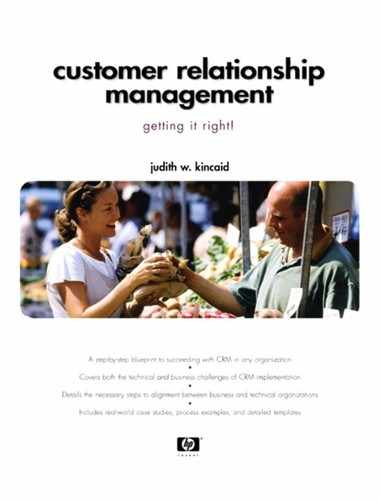2.3. Defining Customer Experience Management
As you saw in Figure 2-5, the lever labeled Customer Experience Management is comprised of what you do; it is all the company functions that have a direct impact on the customer – generally the operational functions of your business. There are two major groupings of functions: the back office functions that contribute to the creation of products and services, and the front office functions that interact with the customer directly and often deliver the product or service. Many companies, for example IBM, prefer terms like “customer facing” and “product generation” to label the front office and back office processes. (Some people feel that a “back office” is a place no one would want to work.) For simplicity, we will use the more common (and shorter) terms throughout this book.
2.3.1. Back Office Functions
The back office, shown in Figure 2-9, is comprised of functions such as R&D, manufacturing, procurement, quality, etc., because these are all involved in the development, construction, and delivery of the product or service itself.
Figure 2-9. The back office delivers critical elements of the total customer experience.

For product manufacturers, the back office touches the customer indirectly through the product. A company's core product definitely has a huge impact on the customer's experience. Each time a customer interacts with your product/service he finds the answers to these questions for himself.
Is it easy to set up?
Does it make sense?
Does it run?
Does it do what I expect?
Is it simple to use?
The product/service is created by our back office organizations, and they are responsible for this element of the customer experience. Lots of attention has been paid to the back office functions since the beginning of the industrial age. From the early days of Frederick Taylor's time studies and his system of “Scientific Management” through “Supply Chain Management” and beyond, we have continued to study and improve the way we design, build, and deliver products and services.
Many companies have invested heavily in reengineering their entire supply chain processes. Some of these efforts have been extremely successful, and unfortunately many have not. Reengineering the core of a company is difficult, time consuming, and often very expensive. The expected rewards are large, usually aimed at increased efficiency and cost reduction. Cost cutting keeps companies competitive on price and can increase margin and profit, but there is an absolute limit to the amount of money that can be eliminated from the cost. If we pass along the cost reduction by reducing price, we have sacrificed profit margin for sales volume – and not increased loyalty at all. Low prices do not build loyalty…ever. Low prices only influence buying behavior until someone comes along with a better price than yours.
Enterprise Requirements Planning (ERP) is the label that has been given to all the functions, activities, and processes that comprise the organization's back office. Unfortunately, the same label has been given to the software applications that automate these functions and processes. This has led many to think that ERP is the software, a primary cause of back office reengineering failures. Back-end activities are critical to business success, but they're not the whole story.
2.3.2. Front Office Functions
The front office organizations include marketing, sales, customer service, product support, and any channel partner organizations that perform any of these functions for you, as shown in Figure 2-10.
Figure 2-10. These four functions form the organization's front office.

The front office functions directly communicate and interact with customers through various media such as face-to-face contacts, telephone, mail, the Internet, etc. The other major component of the customer's experience is formed when she interacts with our people and processes and finds the answer to these and similar questions:
Are they competent?
Are they respectful?
Do they keep me informed?
Do they play fair?
Are they flexible?
The front office designs and delivers customer interactions. It is responsible for the relationship piece of the customer experience. Until recently, little attention has been focused on organizing or automating the front office. Sales and marketing have been considered to be arts – not sciences that could be studied and measured and improved.
With the emerging understanding that loyalty is a key component of competitive success, interest in the front office has grown dramatically. The front office is thought to be ripe for automation and process improvements. Just as the software products automating the back office functions have been grouped together in the solution set called Enterprise Requirements Planning, the software that supports and integrates the front office has been grouped under the label Customer Relationship Management. It's critical that we not make the same mistake with automating the front office processes as we did with the back office automation efforts. We can't let ourselves think that the software tool is the whole solution. It's a very necessary enabler, as we'll discuss later, but only an enabler.
